Cooperative Truck–Drone Delivery Path Optimization under Urban Traffic Restriction
Abstract
1. Introduction
- We present the problem of cooperative truck–drone path optimization for delivering parcels to customers in restricted traffic zones.
- We propose a hybrid metaheuristic and convex relaxation optimization algorithm to efficiently solve the problem.
- We validate the effectiveness and efficiency of the proposed method on a variety of test instances.
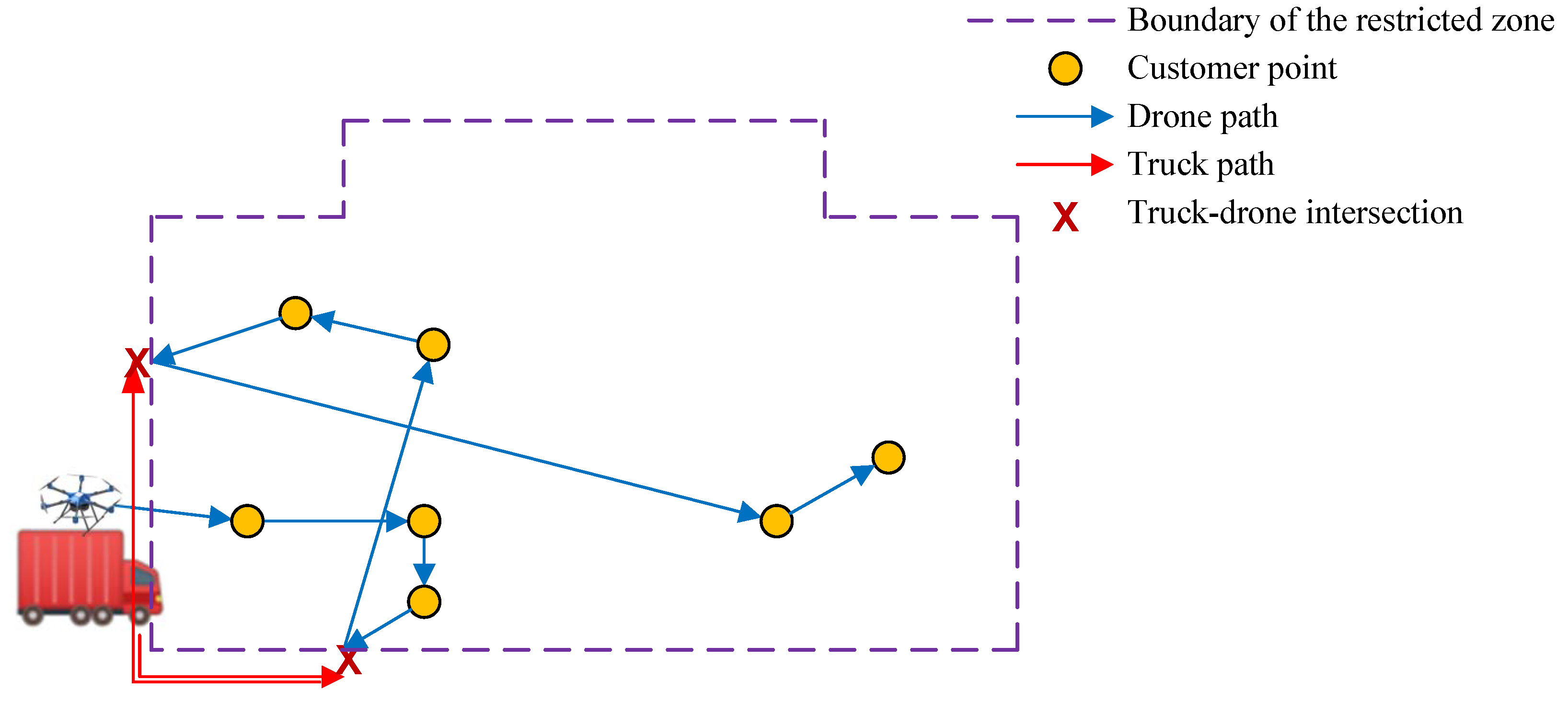
2. Related Work
3. Problem Description
- According to the weight capacity limitation, the drone cannot load the cargo for the next customer:
- According to the power and consequent distance limitation, the drone cannot fly to the next customer and then return back to the truck:
4. A Hybrid Optimization Method for the Problem
4.1. Main Metaheuristic for Optimizing the Drone Path
| Algorithm 1: Simplified WWO algorithm adapted to optimize the drone path for the problem. |
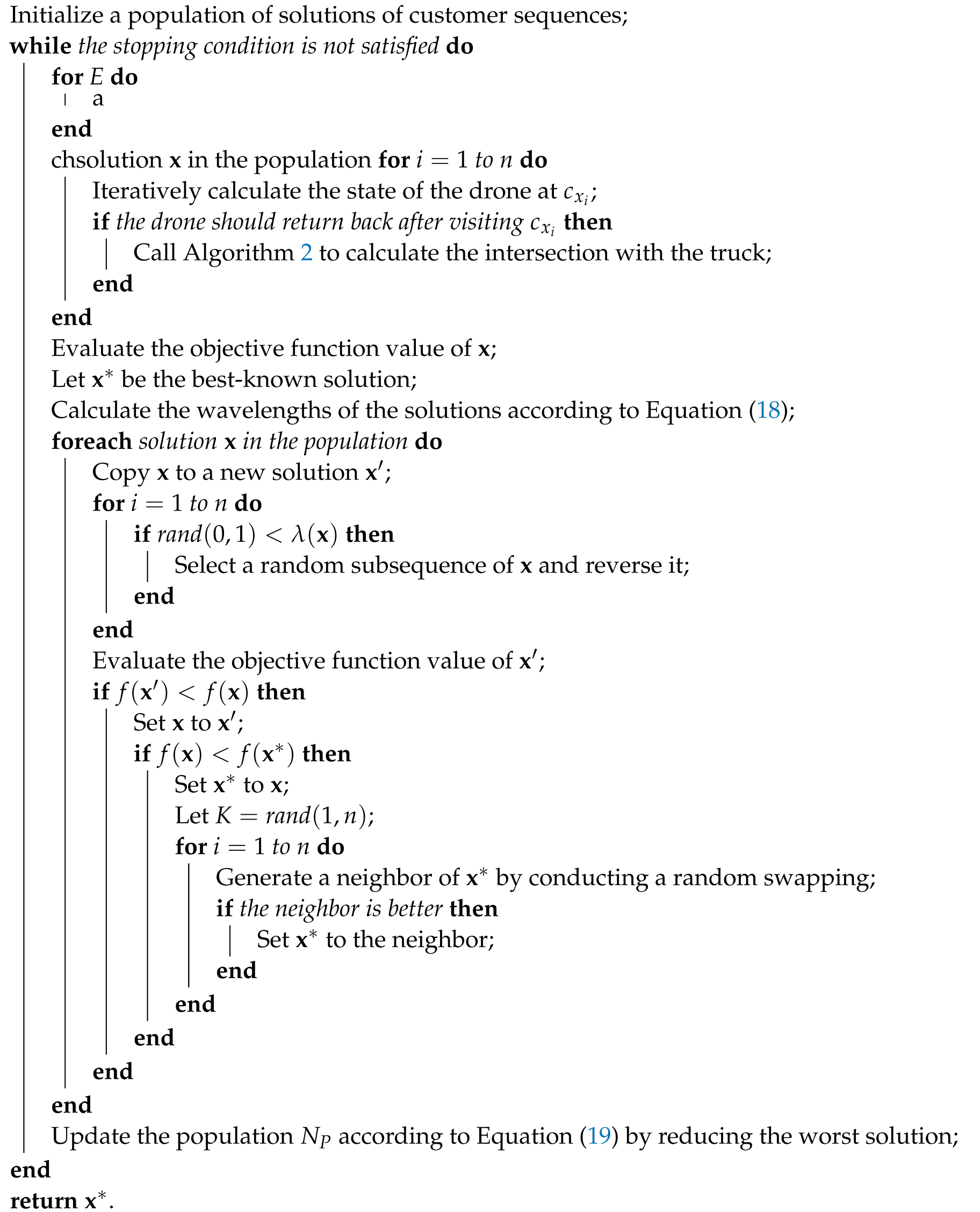 |
4.2. Sub-Procedure for Optimizing Truck–Drone Intersections
| Algorithm 2: Algorithm for finding the intersection of the truck and the drone. |
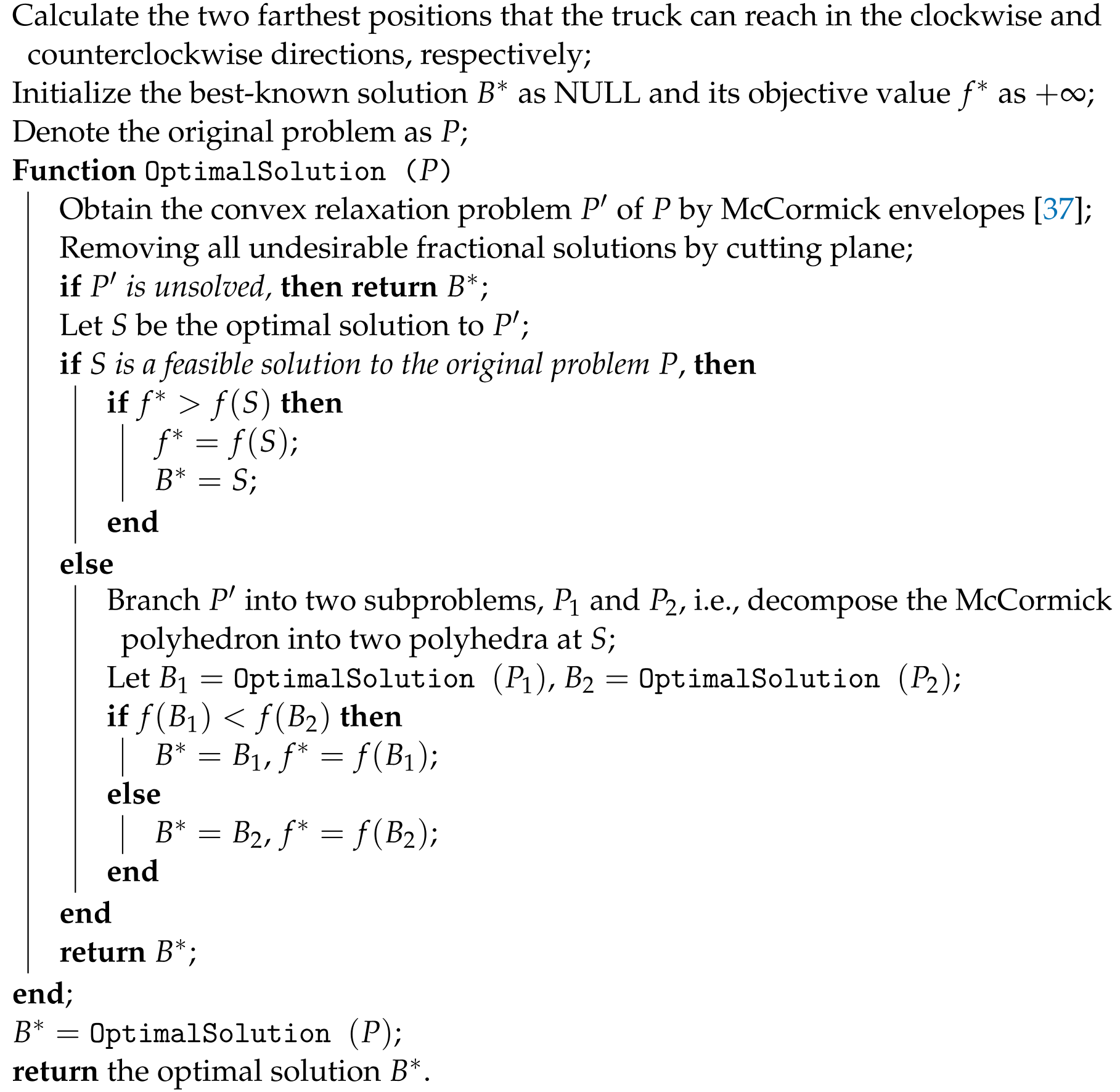 |
5. Computational Experiments
- A GA that uses linear order crossover and shift-change mutation [38].
- A DE algorithm for permutation optimization based on floating-to-integer mapping [41].
- A discrete PSO adapted to this problem using subsequence learning [42].
- Enhanced BBO [43] that integrates local and global subsequence migration.
- Basic WWO [44] adapted to this problem using subsequence reverse propagation.
6. Conclusions
Author Contributions
Funding
Informed Consent Statement
Data Availability Statement
Conflicts of Interest
References
- Zhang, L.; Long, R.; Chen, H. Do car restriction policies effectively promote the development of public transport? World Dev. 2019, 119, 100–110. [Google Scholar] [CrossRef]
- Chen, X.; Wu, G.; Li, D. Efficiency measure on the truck restriction policy in China: A non-radial data envelopment model. Transp. Res. Part A Policy Pract. 2019, 129, 140–154. [Google Scholar] [CrossRef]
- Lemardelé, C.; Estrada, M.; Pagès, L.; Bachofner, M. Potentialities of drones and ground autonomous delivery devices for last-mile logistics. Transp. Res. Part E Logis. Transp. Rev. 2021, 149, 102325. [Google Scholar] [CrossRef]
- Sham, R.; Siau, C.S.; Tan, S.; Kiu, D.C.; Sabhi, H.; Thew, H.Z.; Selvachandran, G.; Quek, S.G.; Ahmad, N.; Ramli, M.H.M. Drone usage for medicine and vaccine delivery during the covid-19 pandemic: Attitude of health care workers in rural medical centres. Drones 2022, 6, 109. [Google Scholar] [CrossRef]
- Zheng, Y.J.; Chen, X.; Song, Q.; Yang, J.; Wang, L. Evolutionary optimization of COVID-19 vaccine distribution with evolutionary demands. IEEE Trans. Evol. Comput. 2022, in press. [Google Scholar] [CrossRef]
- Karatas, M.; Erişkin, L.; Bozkaya, E. Transportation and location planning during epidemics/pandemics: Emerging problems and solution approaches. IEEE Trans. Intell. Transp. Syst. 2022, 23, 25139–25156. [Google Scholar] [CrossRef]
- Chen, X.; Yan, H.F.; Zheng, Y.J.; Karatas, M. Integration of machine learning prediction and heuristic optimization for mask delivery in COVID-19. Swarm Evol. Comput. 2023, 76, 101208. [Google Scholar] [CrossRef]
- Li, T. A SWOT analysis of China’s air cargo sector in the context of COVID-19 pandemic. J. Air Transp. Manag. 2020, 88, 101875. [Google Scholar] [CrossRef]
- Hwang, J.; Kim, H. The effects of expected benefits on image, desire, and behavioral intentions in the field of drone food delivery services after the outbreak of COVID-19. Sustainability 2021, 13, 117. [Google Scholar] [CrossRef]
- Hong, I.; Kuby, M.; Murray, A.T. A range-restricted recharging station coverage model for drone delivery service planning. Transp. Res. Part C Emerg. Technol. 2018, 90, 198–212. [Google Scholar] [CrossRef]
- Bányai, T. Impact of the integration of first-mile and last-mile drone-based operations from trucks on energy efficiency and the environment. Drones 2022, 6, 249. [Google Scholar] [CrossRef]
- Salama, M.R.; Srinivas, S. Collaborative truck multi-drone routing and scheduling problem: Package delivery with flexible launch and recovery sites. Transp. Res. Part E Logis. Transp. Rev. 2022, 164, 102788. [Google Scholar] [CrossRef]
- Wells, G.; Stevens, L. Amazon Conducts First Commercial Drone Delivery. Available online: https://www.wsj.com/articles/amazon-conducts-first-commercial-drone-delivery-1481725956 (accessed on 1 November 2022).
- Burgess, M. DHL’s Delivery Drone Can Make Drops Quicker than a Car. Available online: http://www.wired.co.uk/article/dhl-drone-delivery-germany/ (accessed on 1 November 2022).
- Tilley, A. UPS experiments with drone delivery in partnership with Zipline. Available online: https://www.forbes.com/sites/aarontilley/2016/05/09/ups-experiments-with-drone-delivery-in-partnership-with-zipline/#58f1c1d145a4 (accessed on 1 November 2022).
- SF Tech. SF UAV. Available online: https://www.sf-tech.com.cn/en/product/uav (accessed on 1 November 2022).
- Poikonen, S.; Golden, B. Multi-visit drone routing problem. Comput. Oper. Res. 2020, 113, 104802. [Google Scholar] [CrossRef]
- Benarbia, T.; Kyamakya, K. A literature review of drone-based package delivery logistics systems and their implementation feasibility. Sustainability 2022, 14, 360. [Google Scholar] [CrossRef]
- Murray, C.C.; Chu, A.G. The flying sidekick traveling salesman problem: Optimization of drone-assisted parcel delivery. Transp. Res. Part C Emerg. Technol. 2015, 54, 86–109. [Google Scholar] [CrossRef]
- Murray, C.C.; Raj, R. The multiple flying sidekicks traveling salesman problem: Parcel delivery with multiple drones. Transp. Res. Part C Emerg. Technol. 2020, 110, 368–398. [Google Scholar] [CrossRef]
- Ham, A.M. Integrated scheduling of m-truck, m-drone, and m-depot constrained by time-window, drop-pickup, and m-visit using constraint programming. Transp. Res. Part C Emerg. Technol. 2018, 91, 1–14. [Google Scholar] [CrossRef]
- Agatz, N.; Bouman, P.; Schmidt, M. Optimization approaches for the traveling salesman problem with drone. Transp. Sci. 2018, 52, 965–981. [Google Scholar] [CrossRef]
- Ulmer, M.W.; Thomas, B.W. Same-day delivery with heterogeneous fleets of drones and vehicles. Networks 2018, 72, 475–505. [Google Scholar] [CrossRef]
- Wu, G.; Mao, N.; Luo, Q.; Xu, B.; Shi, J.; Suganthan, P.N. Collaborative truck-drone routing for contactless parcel delivery during the epidemic. IEEE Trans. Intell. Transp. Syst. 2022, 23, 25077–25091. [Google Scholar] [CrossRef]
- Zheng, Y.; Du, Y.; Ling, H.; Sheng, W.; Chen, S. Evolutionary collaborative human-UAV search for escaped criminals. IEEE Trans. Evol. Comput. 2020, 24, 217–231. [Google Scholar] [CrossRef]
- Zheng, Y.J.; Du, Y.C.; Sheng, W.G.; Ling, H.F. Collaborative human-UAV search and rescue for missing tourists in nature reserves. INFORMS J. Appl. Anal. 2019, 49, 371–383. [Google Scholar] [CrossRef]
- Zheng, Y.J.; Du, Y.C.; Su, Z.L.; Ling, H.F.; Zhang, M.X.; Chen, S.Y. Evolutionary human-UAV cooperation for transmission network restoration. IEEE Trans. Ind. Inform. 2021, 17, 1648–1657. [Google Scholar] [CrossRef]
- Carlsson, J.G.; Song, S. Coordinated logistics with a truck and a drone. Manag. Sci. 2018, 64, 4052–4069. [Google Scholar] [CrossRef]
- Wang, Z.; Sheu, J.B. Vehicle routing problem with drones. Transp. Res. Part B Method. 2019, 122, 350–364. [Google Scholar] [CrossRef]
- Luo, Z.; Liu, Z.; Shi, J. A two-echelon cooperated routing problem for a ground vehicle and its carried unmanned aerial vehicle. Sensors 2017, 17, 1144. [Google Scholar] [CrossRef]
- Karak, A.; Abdelghany, K. The hybrid vehicle-drone routing problem for pick-up and delivery services. Transp. Res. Part C Emerg. Technol. 2019, 102, 427–449. [Google Scholar] [CrossRef]
- Savuran, H.; Karakaya, M. Efficient route planning for an unmanned air vehicle deployed on a moving carrier. Soft Comput. 2016, 20, 2905–2920. [Google Scholar] [CrossRef]
- Boysen, N.; Briskorn, D.; Fedtke, S.; Schwerdfeger, S. Drone delivery from trucks: Drone scheduling for given truck routes. Networks 2018, 72, 506–527. [Google Scholar] [CrossRef]
- Poikonen, S.; Golden, B. The mothership and drone routing problem. INFORMS J. Comput. 2020, 32, 249–262. [Google Scholar] [CrossRef]
- Fawaz, W.; Atallah, R.; Assi, C.; Khabbaz, M. Unmanned aerial vehicles as store-carry-forward nodes for vehicular networks. IEEE Access 2017, 5, 23710–23718. [Google Scholar] [CrossRef]
- Chung, S.H.; Sah, B.; Lee, J. Optimization for drone and drone-truck combined operations: A review of the state of the art and future directions. Comput. Oper. Res. 2020, 123, 105004. [Google Scholar] [CrossRef]
- Castro, P.M. Tightening piecewise McCormick relaxations for bilinear problems. Comput. Chem. Eng. 2015, 72, 300–311. [Google Scholar] [CrossRef]
- Wang, H.F.; Wu, K.Y. Hybrid genetic algorithm for optimization problems with permutation property. Comput. Oper. Res. 2004, 31, 2453–2471. [Google Scholar] [CrossRef]
- Simon, D. Biogeography-based optimization. IEEE Trans. Evol. Comput. 2008, 12, 702–713. [Google Scholar] [CrossRef]
- Wang, X.; Duan, H. A hybrid biogeography-based optimization algorithm for job shop scheduling problem. Comput. Ind. Eng. 2014, 73, 96–114. [Google Scholar] [CrossRef]
- Chakraborty, U.K.; Turvey, K.P. Floating-point to integer mapping schemes in differential evolution for permutation flow shop scheduling. Int. J. Bio-Inspired Comput. 2010, 2, 183–204. [Google Scholar] [CrossRef]
- Wang, X.; Tang, L. A discrete particle swarm optimization algorithm with self-adaptive diversity control for the permutation flowshop problem with blocking. Appl. Soft Comput. 2012, 12, 652–662. [Google Scholar] [CrossRef]
- Zheng, Y.J.; Ling, H.F.; Xue, J.Y. Ecogeography-based optimization: Enhancing biogeography-based optimization with ecogeographic barriers and differentiations. Comput. Oper. Res. 2014, 50, 115–127. [Google Scholar] [CrossRef]
- Zheng, Y.J. Water wave optimization: A new nature-inspired metaheuristic. Comput. Oper. Res. 2015, 55, 1–11. [Google Scholar] [CrossRef]
- Han, H.; Lu, W.; Qiao, J. An adaptive multiobjective particle swarm optimization based on multiple adaptive methods. IEEE Trans. Cybern. 2017, 47, 2754–2767. [Google Scholar] [CrossRef] [PubMed]
- Liu, W.; Niu, G.; Cao, Q.; Pun, M.O.; Chen, J. 3-D placement of UAVs based on SIR-measured PSO Algorithm. In Proceedings of the 2019 IEEE Globecom Workshops (GC Wkshps), Waikoloa, HI, USA, 9–13 December 2019; pp. 1–6. [Google Scholar] [CrossRef]
- Siddiqui, A.B.; Aqeel, I.; Alkhayyat, A.; Javed, U.; Kaleem, Z. Prioritized user association for sum-rate maximization in UAV-assisted emergency communication: A reinforcement learning approach. Drones 2022, 6, 45. [Google Scholar] [CrossRef]
- Wu, G.; Fan, M.; Shi, J.; Feng, Y. Reinforcement learning based truck-and-drone coordinated delivery. IEEE Trans. Artif. Intell. 2021, in press. [Google Scholar] [CrossRef]
- Wu, C.X.; Liao, M.H.; Karatas, M.; Chen, S.Y.; Zheng, Y.J. Real-time neural network scheduling of emergency medical mask production during COVID-19. Appl. Soft Comput. 2020, 97, 106790. [Google Scholar] [CrossRef]



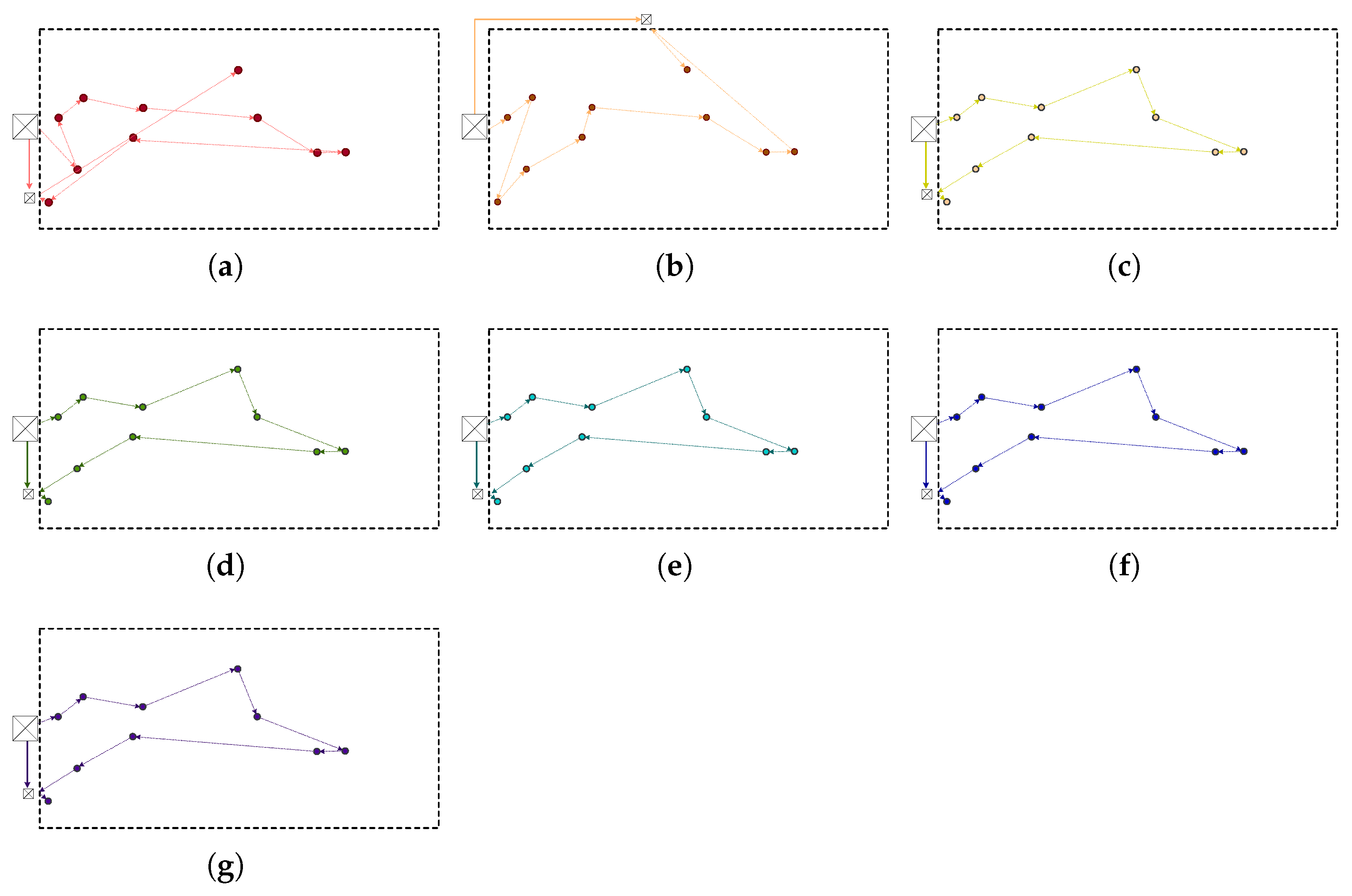

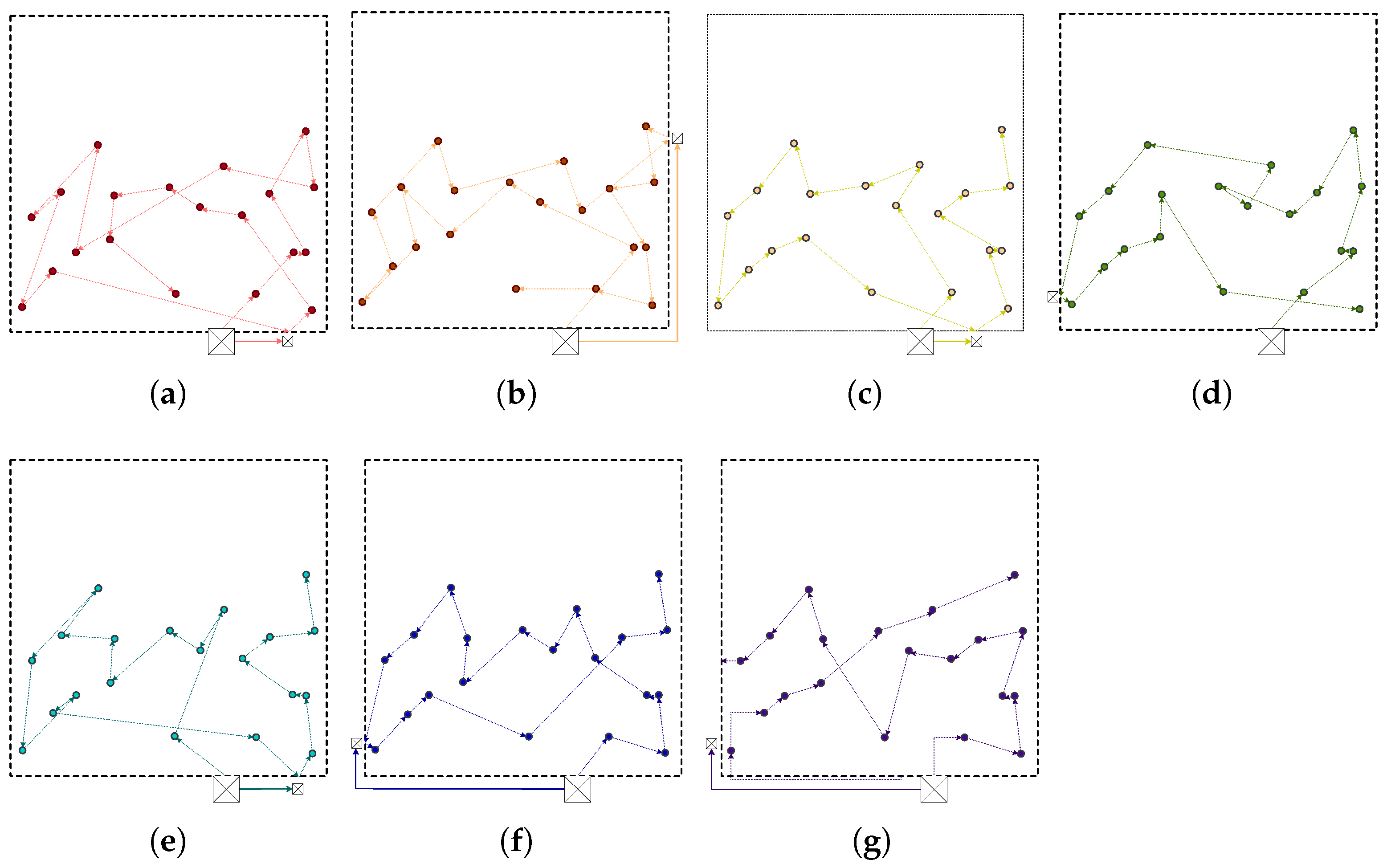



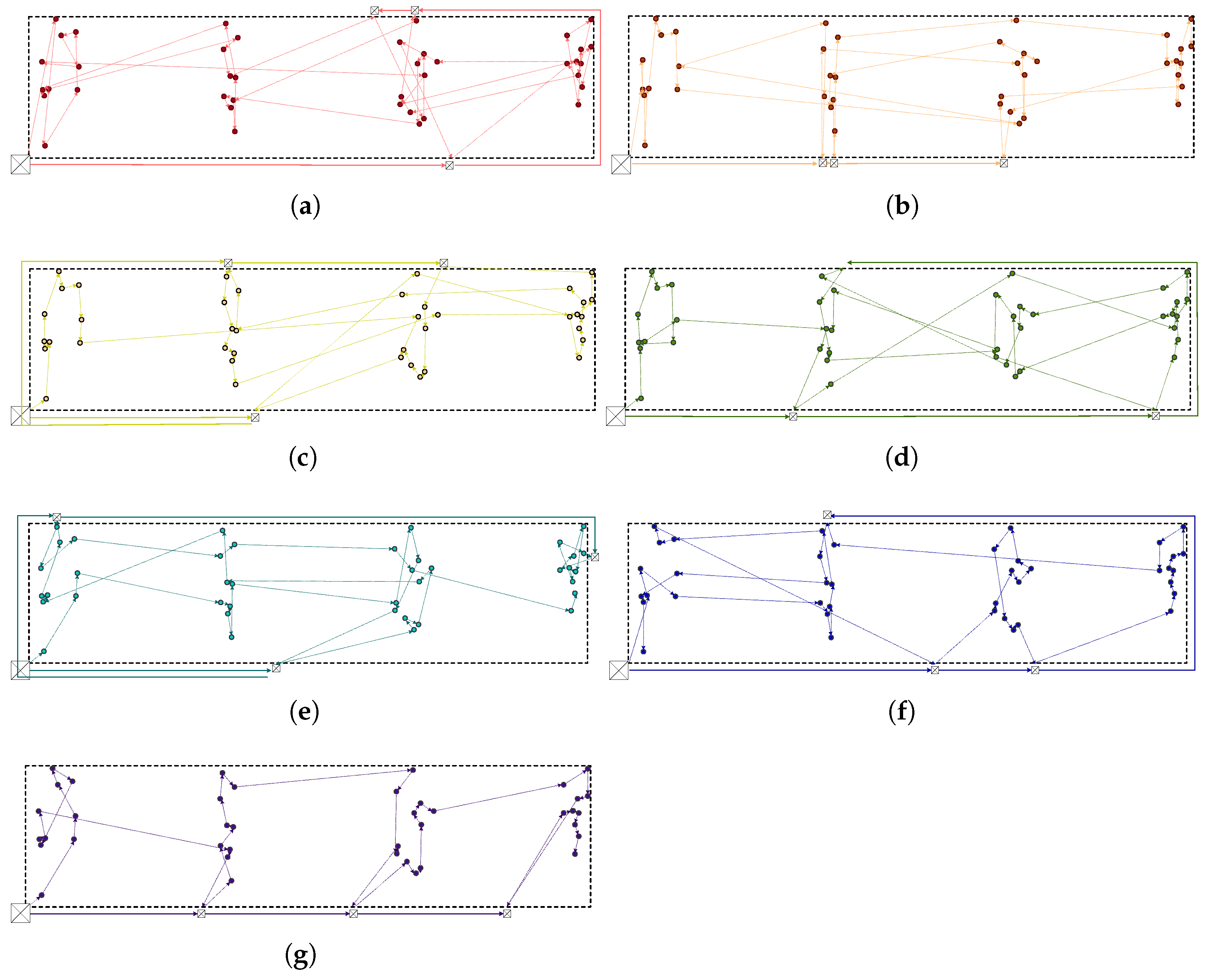
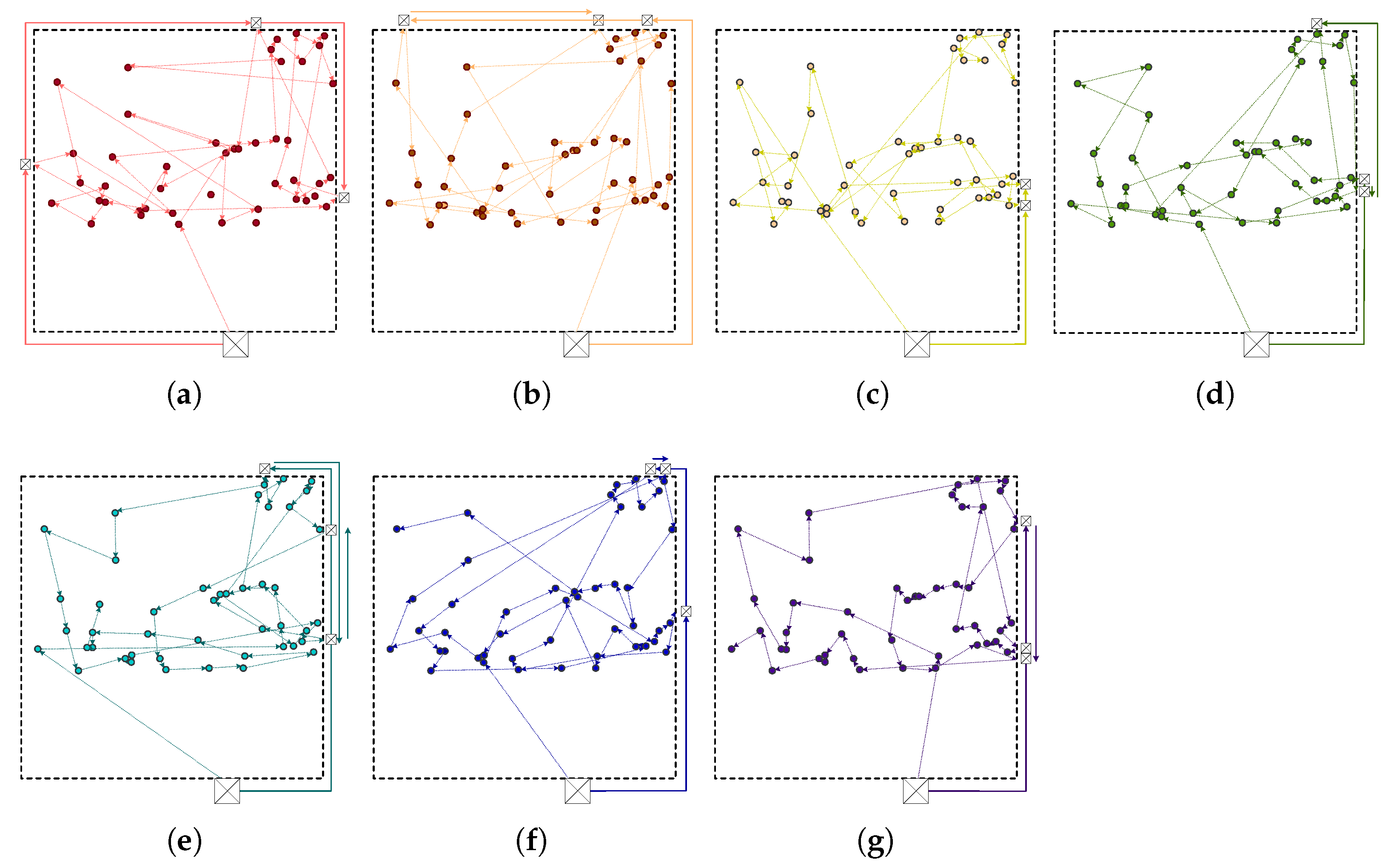
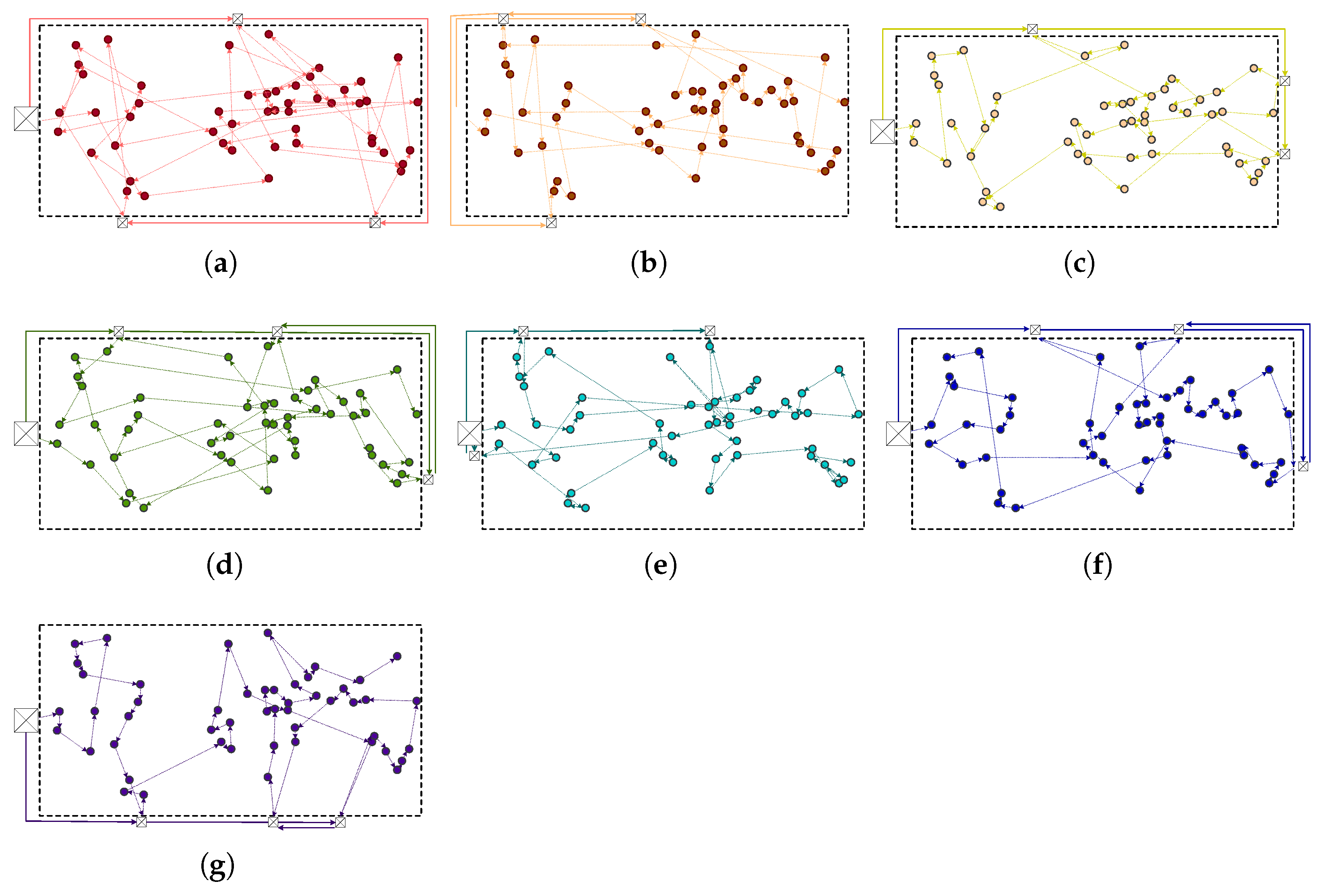
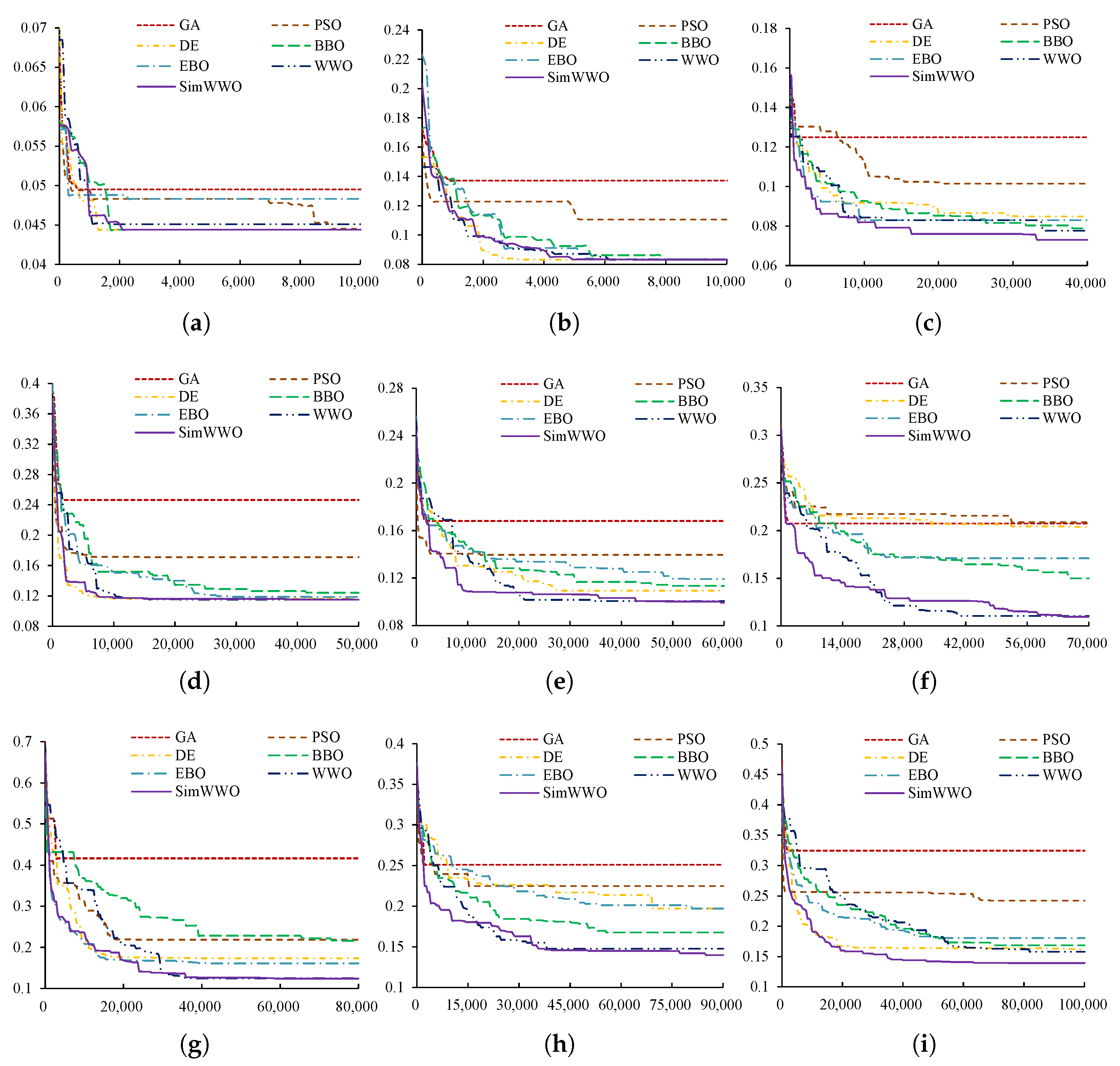
| Parameter | Description |
|---|---|
| n | Number of the customers |
| Initial location the truck and the drone | |
| Location of the i-th customers | |
| Weight of cargo to be delivered to the i-th customer | |
| B | Outer boundary of the restricted traffic zone |
| Velocity of the truck | |
| D | Maximum distance of the drone |
| W | Maximum load of the drone |
| Maximum velocity of the drone | |
| Minimum velocity of the drone |
| Ins. | n | Area (km ) | Perimeter (km) | Average Distance (km) | Average Weight (kg) |
|---|---|---|---|---|---|
| 1 | 10 | 2.00 | 6 | 0.733 | 3.10 |
| 2 | 15 | 2.00 | 9 | 1.414 | 2.33 |
| 3 | 20 | 2.25 | 6 | 0.695 | 2.65 |
| 4 | 25 | 2.00 | 9 | 1.520 | 2.76 |
| 5 | 30 | 2.00 | 6 | 0.720 | 2.27 |
| 6 | 35 | 2.25 | 6 | 0.770 | 2.23 |
| 7 | 40 | 2.00 | 9 | 1.635 | 2.60 |
| 8 | 45 | 2.25 | 6 | 0.665 | 2.36 |
| 9 | 50 | 2.00 | 6 | 0.737 | 2.32 |
| Algorithm | Parameter Setting |
|---|---|
| GA | , crossover rate: 0.95, mutation rate: 0.2 |
| BBO | , mutation rate: 0.1 |
| DE | , crossover rate: 0.9, scale factor: 0.5 |
| PSO | , maximum inertia weight: 0.9, minimum inertia weight: 0.4 |
| EBO | , maximum maturity: 0.6, minimum maturity: 0.3 |
| WWO | , maximum wave height: 12, maximum number of breaking waves: 12 |
| SimWWO | , , maximum number of breaking waves: 12 |
| Ins. | n | Metrics | GA | PSO | DE | BBO | EBO | WWO | SimWWO |
|---|---|---|---|---|---|---|---|---|---|
| 1 | 10 | median | 0.0548 | 0.0483 | 0.0444 | 0.0444 | 0.0444 | 0.0444 | 0.0444 |
| max | 0.0628 | 0.0530 | 0.0483 | 0.0451 | 0.0489 | 0.0451 | 0.0444 | ||
| min | 0.0451 | 0.0445 | 0.0444 | 0.0444 | 0.0444 | 0.0444 | 0.0444 | ||
| std | 0.0056 | 0.0025 | 0.0017 | 0.0002 | 0.0008 | 0.0003 | 0.0000 | ||
| 2 | 15 | median | 0.1194 | 0.0920 | 0.0832 | 0.0834 | 0.0835 | 0.0832 | 0.0832 |
| max | 0.1738 | 0.1268 | 0.0979 | 0.0974 | 0.0967 | 0.0833 | 0.0832 | ||
| min | 0.0884 | 0.0832 | 0.0832 | 0.0832 | 0.0832 | 0.0832 | 0.0832 | ||
| std | 0.0198 | 0.0138 | 0.0028 | 0.0029 | 0.0041 | 0.0000 | 0.0000 | ||
| 3 | 20 | median | 0.1118 | 0.0912 | 0.0830 | 0.0793 | 0.0844 | 0.0760 | 0.0730 |
| max | 0.1331 | 0.1184 | 0.0901 | 0.0861 | 0.0904 | 0.0867 | 0.0748 | ||
| min | 0.0931 | 0.0839 | 0.0767 | 0.0742 | 0.0786 | 0.0714 | 0.0714 | ||
| std | 0.0079 | 0.0073 | 0.0034 | 0.0032 | 0.0032 | 0.0038 | 0.0011 | ||
| 4 | 25 | median | 0.2399 | 0.1476 | 0.1268 | 0.1257 | 0.1259 | 0.1153 | 0.1150 |
| max | 0.2882 | 0.2060 | 0.1677 | 0.1498 | 0.1562 | 0.1476 | 0.1155 | ||
| min | 0.1787 | 0.1190 | 0.1166 | 0.1192 | 0.1163 | 0.1147 | 0.1147 | ||
| std | 0.0294 | 0.0269 | 0.0119 | 0.0083 | 0.0111 | 0.0059 | 0.0002 | ||
| 5 | 30 | median | 0.1784 | 0.1401 | 0.1151 | 0.1171 | 0.1264 | 0.1077 | 0.1012 |
| max | 0.2160 | 0.1661 | 0.1319 | 0.1264 | 0.1352 | 0.1212 | 0.1086 | ||
| min | 0.1575 | 0.1226 | 0.1023 | 0.1075 | 0.1141 | 0.0958 | 0.0899 | ||
| std | 0.0168 | 0.0101 | 0.0067 | 0.0045 | 0.0055 | 0.0068 | 0.0037 | ||
| 6 | 35 | median | 0.2159 | 0.2162 | 0.1976 | 0.1472 | 0.1761 | 0.1323 | 0.1195 |
| max | 0.2418 | 0.2348 | 0.2190 | 0.1611 | 0.1907 | 0.1437 | 0.1294 | ||
| min | 0.1939 | 0.1874 | 0.1847 | 0.1147 | 0.1567 | 0.1048 | 0.1039 | ||
| std | 0.0117 | 0.0108 | 0.0084 | 0.0081 | 0.0092 | 0.0105 | 0.0072 | ||
| 7 | 40 | median | 0.4163 | 0.2473 | 0.2046 | 0.2090 | 0.1850 | 0.1247 | 0.1238 |
| max | 0.5232 | 0.3696 | 0.2566 | 0.2337 | 0.2274 | 0.1268 | 0.1250 | ||
| min | 0.3262 | 0.1807 | 0.1510 | 0.1682 | 0.1578 | 0.1232 | 0.1232 | ||
| std | 0.0537 | 0.0498 | 0.0243 | 0.0174 | 0.0174 | 0.0009 | 0.0006 | ||
| 8 | 45 | median | 0.2479 | 0.2288 | 0.1919 | 0.1737 | 0.1800 | 0.1455 | 0.1398 |
| max | 0.2775 | 0.2512 | 0.2138 | 0.1825 | 0.1972 | 0.1686 | 0.1495 | ||
| min | 0.1993 | 0.1855 | 0.1470 | 0.1575 | 0.1620 | 0.1226 | 0.1226 | ||
| std | 0.0169 | 0.0185 | 0.0156 | 0.0059 | 0.0095 | 0.0108 | 0.0067 | ||
| 9 | 50 | median | 0.3304 | 0.2169 | 0.1708 | 0.1832 | 0.1895 | 0.1406 | 0.1376 |
| max | 0.3774 | 0.2569 | 0.1990 | 0.2200 | 0.2132 | 0.1620 | 0.1466 | ||
| min | 0.2997 | 0.1633 | 0.1447 | 0.1664 | 0.1496 | 0.1171 | 0.1167 | ||
| std | 0.0204 | 0.0224 | 0.0127 | 0.0119 | 0.0124 | 0.0111 | 0.0068 | ||
| average (median) | 0.2127 | 0.1587 | 0.1353 | 0.1292 | 0.1328 | 0.1077 | 0.1041 | ||
Disclaimer/Publisher’s Note: The statements, opinions and data contained in all publications are solely those of the individual author(s) and contributor(s) and not of MDPI and/or the editor(s). MDPI and/or the editor(s) disclaim responsibility for any injury to people or property resulting from any ideas, methods, instructions or products referred to in the content. |
© 2023 by the authors. Licensee MDPI, Basel, Switzerland. This article is an open access article distributed under the terms and conditions of the Creative Commons Attribution (CC BY) license (https://creativecommons.org/licenses/by/4.0/).
Share and Cite
Weng, Y.-Y.; Wu, R.-Y.; Zheng, Y.-J. Cooperative Truck–Drone Delivery Path Optimization under Urban Traffic Restriction. Drones 2023, 7, 59. https://doi.org/10.3390/drones7010059
Weng Y-Y, Wu R-Y, Zheng Y-J. Cooperative Truck–Drone Delivery Path Optimization under Urban Traffic Restriction. Drones. 2023; 7(1):59. https://doi.org/10.3390/drones7010059
Chicago/Turabian StyleWeng, Ying-Ying, Rong-Yu Wu, and Yu-Jun Zheng. 2023. "Cooperative Truck–Drone Delivery Path Optimization under Urban Traffic Restriction" Drones 7, no. 1: 59. https://doi.org/10.3390/drones7010059
APA StyleWeng, Y.-Y., Wu, R.-Y., & Zheng, Y.-J. (2023). Cooperative Truck–Drone Delivery Path Optimization under Urban Traffic Restriction. Drones, 7(1), 59. https://doi.org/10.3390/drones7010059







